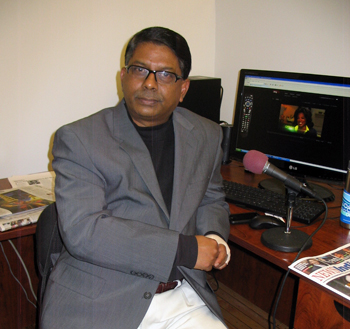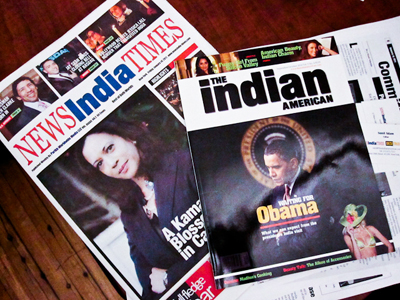This is the third article in FI2W’s series on how New York newspapers that serve immigrant communities are adapting to changes in the economy and the revolution in news gathering and distribution.
The recession was officially over when journalist Sunil Adam was recruited to News India Times two years ago, but the economy and the state of the paper were still fragile. Advertisers were pulling out, and the Times‘ new management wondered whether the decision to buy at the “right price” had been ill-advised.
There was a “considerable drop” in revenue,” admitted Adam, the 54 year old Editor-in-Chief of the Times, a national paper founded in 1975 and considered the flagship of PWM. It’s one of the largest papers serving the Indian community in the New York area—second only to the older India Abroad. Adam edits PWM’s two other English publications as well: Desi Talk, a paper that serves the New York Tri-State area and The Indian American, a glossy lifestyle magazine. The company also publishes Gujarat Times, a paper written in Gujarati, the language spoken by Mohandas Gandhi.
The News India Times covers the life and times of Indians in the United States and reports them back to the 2.7 million Indian immigrants across the country. It does not cover Indians in their native country, unless, Adam said, the news is huge and has repercussions on the Indian immigrant community here. When FI2W came to visit, the cover featured Kamala Devi Harris, the recently elected attorney general of California. There is also a lot of interest in celebrities such as “The Good Wife” actress Archie Panjabi and “Top Chef” host Padma Lakshmi.
“It’s an incestuous relationship,” Adam said. “You have to be of your own community to know your community.”
The papers were acquired by Parikh Worldwide Media (PWM) in 2009, a company owned by Dr. Sudhir Parikh who operates asthma and allergy centers throughout New York and New Jersey. Just as the new owners were beginning to build on their acquisition, the downturn wiped out some of their gains.
Mirroring the fate of mainstream media, when the recession began, News India Times was forced to lay off two reporters and never replaced them. Adam made a wry comment about journalists being the first to go, a reality in many newsroom shakeups. The paper did not cut its size or reduce the number of pages, and citing the folksy wisdom that guided the decision, he said, “in media, whatever your problems are, you should not show it in public.”
Listen to Sunil Adam, Editor-in-Chief of News India Times, talk about the state of his paper:
[audio: fi2w_suniladams_pastor.mp3]“We lost the mainstream advertising, the big banks, the airlines,” the smartly attired Adam said, speaking with a slight British accent. “Understandably, these companies faced the recessionary trends much more, so they tend to cut down on their budgets,” he added. What remained were the shopkeepers, the store owners, movies, not to mention pages of matrimonial classifieds common among Indian publications.
Today revenues are slowly rebounding, said Adam, interviewed at the paper’s airy Manhattan office as reporters were finishing up the week’s issue so they could get home before a snowstorm hit the city. “We’re more optimistic this year,” he added, attributing the paper’s survival to a dedicated readership and the small company’s low overhead.
“The ethnic media market is a fairly captive market. The people advertise with us not only because we are bloody cheap but we are the only way they can target their markets,” Adam said.
“We make do with very little, so we keep our heads above water,” Adam noted, echoing the often heard perspective in the ethnic media community that because they’re small, their losses are comparatively minimal. The downsizing at News India Times eventually paid off. “We’re profitable now,” Adam confirmed.
The paper runs on the diligence and flexibility of three reporters, a photographer, a managing editor, and Adam—all of them paid “decent wages,” he said. Also contributing content is a corps of freelancers across the country. The publications essentially share the same editorial staff.
“Our reporters do everything—write, take pictures, post on the web, do html,” said Adam. “As editor, my job description involves anything including vacuuming.”
Adam says most of his readers are first generation Indian Americans, but there are also non-immigrant subscribers who are interested in hearing the Indian community’s perspective on news—think tanks, researchers and the like—particularly as Indian Americans gain political prominence, as evidenced in Governors Bobby Jindal (R-LA) and Nikki Haley (R-S.C.). “People want to know us, our perspectives on American politics,” Adam surmised.
The Indian American community—and the Times readership—is mostly scattered across the northeast, the Chicago area, Los Angeles and the south, where many Indian doctors practice, Adam said. The community, and the Times readership, is mainly made up of legal residents, students and skilled workers on H1-B visas, many of whom are growing in affluence, according to the Indian Embassy.
The Indian American community has a strong presence in the technology field, which led to Adam’s latest endeavor to expand readership. The News India Times website is more of a portal, with content blended from the three English publications. But the publishers believe it can do more. They want to reach second generation Indian Americans and are looking to invest to make the website available as an iPad app, thus eliminating the print and mailing costs for subscribers outside of the Tri-State area.
“That’s an experiment we have to try out,” Adam said. Ethnic media on the iPad? Stay tuned.
Read the first and second articles in Fi2W’s ethnic media series.
Cristina Pastor is a Feet in Two Worlds business and economics reporting fellow. Her work, and the work of other Fi2W fellows, is supported by the New York Community Trust and the John S. and James L. Knight Foundation with additional support from the Mertz Gilmore Foundation.






